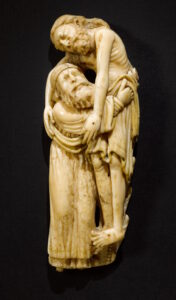 A section of a wooden boat discovered in Oslo is much older than archaeologists thought, and indeed may be Oslo’s oldest boat part. Researchers from the Norwegian Institute for Cultural Heritage Research (NIKU) discovered on the seabed in Bjørvika, a neighborhood east of the city center of Oslo in an inlet of the fjord. It was Oslo’s harbor from the time of its founding by Norway’s last Viking king Harald Hardrada in 1048 through the 17th century. The area is rife with shipwreck remains. Most of them date to the 16th and 17th centuries; there are a number from the 14th century and only one dating back to the 13th century.
A section of a wooden boat discovered in Oslo is much older than archaeologists thought, and indeed may be Oslo’s oldest boat part. Researchers from the Norwegian Institute for Cultural Heritage Research (NIKU) discovered on the seabed in Bjørvika, a neighborhood east of the city center of Oslo in an inlet of the fjord. It was Oslo’s harbor from the time of its founding by Norway’s last Viking king Harald Hardrada in 1048 through the 17th century. The area is rife with shipwreck remains. Most of them date to the 16th and 17th centuries; there are a number from the 14th century and only one dating back to the 13th century.
 In the 2022-2023 excavation, NIKU archaeologists found a well-preserved piece of finely crafted timber in the thick clay of the seabed. It was found under the equally well-preserved remains of a wooden wharf that was dated to approximately 1300. Archaeologists therefore assumed the ship part would date to around the same time, but the shape of the section gave them pause. It was very different from the other shipwreck remains they’d uncovered in the area. It is curved on one side and has a hole in the center through which the mast for the ship’s sail was attached.
In the 2022-2023 excavation, NIKU archaeologists found a well-preserved piece of finely crafted timber in the thick clay of the seabed. It was found under the equally well-preserved remains of a wooden wharf that was dated to approximately 1300. Archaeologists therefore assumed the ship part would date to around the same time, but the shape of the section gave them pause. It was very different from the other shipwreck remains they’d uncovered in the area. It is curved on one side and has a hole in the center through which the mast for the ship’s sail was attached.
Dendrochronological analysis of a sample from the timber revealed the tree it sprouted in 1035 and was felled between 1087 and 1100. That dates it to the end of the Viking Age when Oslo was still a small town, more than 200 years before the wharf the timber was found under was built.
“There’s an aesthetic quality to the ship part we’ve found that we don’t find in the more roughly hewn parts from cargo ships and work ships made in the Middle Ages,” [NIKU archaeologist Håvard] Hegdal tells sciencenorway.no.
“In older ships, it sometimes happens that the planks in the hull are decorated externally with planed lines. But this ship part has decoration on all sides. Even where it has barely been visible,” he says.
Hegdal emphasises that the ship part from Bjørvika cannot be compared with Viking ships like the Gokstad ship from around the year 890, which features more complex lines and specialised planing.
“It showcases both advanced maritime technology and exquisite aesthetics,” he says.













